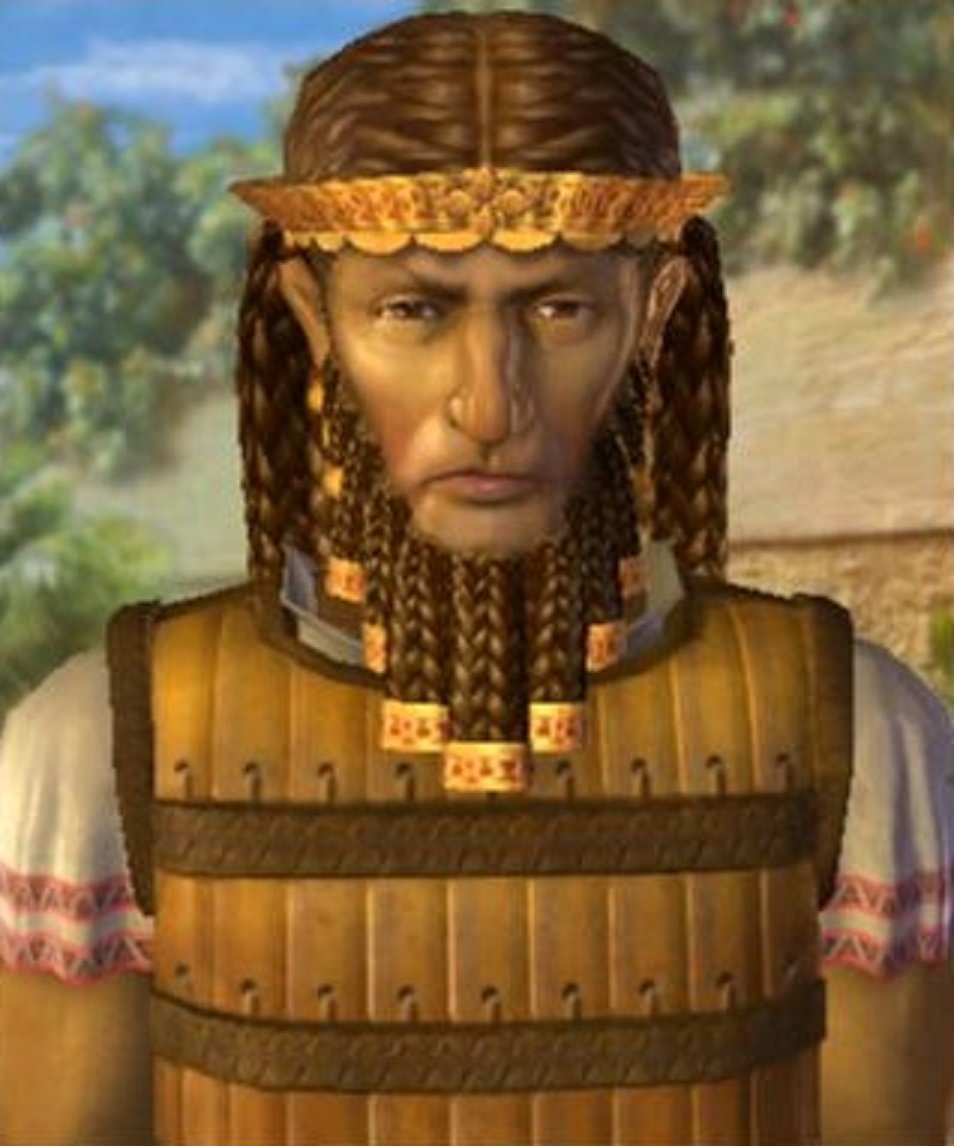



Text source: Wikipedia
GILGAMESH
Gilgamesh (pron.: /ЛҲЙЎЙӘl.ЙЎЙҷ.mЙӣКғ/; Akkadian cuneiform [ ], GilgameЕЎ, often given the epithet of the King, also known as Bilgames in the earliest Sumerian texts)[1] was the fifth king of Uruk, modern day Iraq (Early Dynastic II, first dynasty of Uruk), placing his reign ca. 2500 BC. According to the Sumerian king list he reigned for 126 years. In the Tummal Inscription,[2] Gilgamesh, and his son Urlugal, rebuilt the sanctuary of the goddess Ninlil, in Tummal, a sacred quarter in her city of Nippur. Gilgamesh is the central character in the Epic of Gilgamesh, the greatest surviving work of early Mesopotamian literature. In the epic his father was Lugalbanda and his mother was Ninsun (whom some call Rimat Ninsun), a goddess.
In Mesopotamian mythology, Gilgamesh is a demigod of superhuman strength who built the city walls of Uruk to defend his people from external threats, and travelled to meet the sage Utnapishtim, who had survived the Great Deluge. He is usually described as two-thirds god and one third man.
Cuneiform references
In the Epic of Gilgamesh, Gilgamesh is credited with the building of the legendary walls of Uruk. An alternative version has Gilgamesh telling Urshanabi, the ferryman, that the city's walls were built by theSeven Sages. In historical times, Sargon of Akkad claimed to have destroyed these walls to prove his military power.
Fragments of an epic text found in Me-Turan (modern Tell Haddad) relate that at the end of his life Gilgamesh was buried under the river bed. The people of Uruk diverted the flow of the Euphrates passing Uruk for the purpose of burying the dead king within the river bed. In April 2003, a German expedition claimed to have discovered his last resting place.[3]
It is generally accepted that Gilgamesh was a historical figure, since inscriptions have been found which confirm the historical existence of other figures associated with him: such as the kings Enmebaragesi and Aga of Kish. If Gilgamesh was a historical king, he probably reigned in about the 26th century BC. Some of the earliest Sumerian texts spell his name as Bilgames. Initial difficulties in reading cuneiform resulted in Gilgamesh's making his re-entrance into world culture in 1872 as"Izdubar".[4][5]
In most cuneiform texts, the name of Gilgamesh is preceded with the star-shaped "dingir" determinative ideogram for divine beings, but there is no evidence for a contemporary cult, and the Sumerian Gilgamesh myths suggest that deification was a later development (unlike the case of the Akkadian god-kings). Over the centuries there was a gradual accretion of stories about him, some probably derived from the real lives of other historical figures, in particular Gudea, the Second Dynasty ruler ofLagash (2144вҖ“2124 BC).[6]
Later (non-cuneiform) references
In the Qumran scroll known as Book of Giants (ca. 100 BC) the names of Gilgamesh and Humbaba appear as two of the antediluvian giants (in consonantal form), rendered as glgmЕЎ and бё©wbbyЕЎ. This same text was later used in the Middle East by the Manichaean sects, and the Arabic form Jiljamish survives as the name of a demon according to the Egyptian cleric Al-Suyuti (ca. 1500).[7] The name Gilgamesh appears once in Greek, as "Gilgamos" (О“ОҜО»ОіОұОјОҝПӮ), in Aelian, De Natura Animalium (Of the animal nature) 12.21 (ca. AD 200).[8] In Aelian's story, the King of Babylon, Seuechorus or Euechorus, determined by oracle that his grandson Gilgamos would kill him, so he threw him out of a high tower. An eagle broke his fall, and the infant was found and raised by a gardener, eventually becoming king.
Theodore Bar Konai (ca. AD 600), writing in Syriac, also mentions a king Gligmos, Gmigmos or Gamigos as last of a line of twelve kings who were contemporaneous with the patriarchs from Peleg to Abraham; this occurrence is also considered a vestige of Gilgamesh's former memory.[9][10]
- Link to Wikepedia
- Complete text in PDF - Text source: Wikipedia
- Complete text in Word - Text source: Wikipedia
Text source: Wikipedia
Ш§ШөЩ„ Ш§Щ„ЩҶШө Щ…ЩҶ Щ…ЩҲЩӮШ№ Ш§Щ„ЩҲЩғЩҠШЁЩҠШҜЩҠШ§
Ш¬Щ„Ш¬Ш§Щ…Шҙ
Ш§Щ„ШұШ§ШЁШ· ЩҒЩҠ Щ…ЩҲЩӮШ№ Ш§Щ„ЩҲЩҠЩғЩҠШЁЩҠШҜЩҠШ§
You are welocome to send your comments and proposals as well any useful photos, documents, links for website update using our following address:
Ш§Щ„ШөЩҒШӯШ© ШӘШұШӯШЁ ШЁШ§ЩҠШ© Щ…Щ„Ш§ШӯШёШ§ШӘ Ш§ЩҲ Щ…ЩӮШӘШұШӯШ§ШӘ ЩғЩ…Ш§ ШӘШӘШ·Щ„Ш№ Щ„Ш§ШіШӘЩ„Ш§Щ… Ш§ЩҠШ© ШөЩҲШұ Ш§ЩҲ ЩҲШ«Ш§ШҰЩӮ Ш§ЩҲ ШұЩҲШ§ШЁШ· Щ…ЩҒЩҠШҜШ© Щ„ШӘШӯШҜЩҠШ«ЩҮШ§ Ш№ШЁШұ Ш§Щ„Щ…ШұШ§ШіЩ„Ш© Ш№Щ„Щү Ш§Щ„Ш№ЩҶЩҲШ§ЩҶ Ш§Щ„Ш§Щ„ЩғШӘШұЩҲЩҶЩҠ Ш§Щ„ШӘШ§Щ„ЩҠ
info@uruk-warka.dk
Other updates ... ШӘШӯШҜЩҠШ«Ш§ШӘ Ш§Ш®ШұЩү
Epic of Gilgamesh PDF - 2nd edition Щ…Щ„ШӯЩ…Ш© Ш¬Щ„Ш¬Ш§Щ…Шҙ Ш§Щ„Ш·ШЁШ№Ш© Ш§Щ„Ш«Ш§ЩҶЩҠШ©
Epic of Gilgamesh PDF - 2nd edition (another PDF version) Щ…Щ„ШӯЩ…Ш© Ш¬Щ„Ш¬Ш§Щ…Шҙ Ш§Щ„Ш·ШЁШ№Ш© Ш§Щ„Ш«Ш§ЩҶЩҠШ© - ЩҶШіШ®Ш© Ш«Ш§ЩҶЩҠШ© Ш§Щ„ЩғШӘШұЩҲЩҶЩҠШ©
The Epic of Gilgamesh Щ…Щ„ШӯЩ…Ш© Ш¬Щ„Ш¬Ш§Щ…Шҙ
Spirituality of The Epic of Gilgamesh ШұЩҲШӯЩҠШ© Щ…Щ„ШӯЩ…Ш© Ш¬Щ„Ш¬Ш§Щ…Шҙ
Gilgamesh Short Forms ЩҶШөЩҲШө ЩӮШөЩҠШұШ© Ш№ЩҶ Ш¬Щ„Ш¬Ш§Щ…Шҙ
Epic of Gilgamesh Щ…Щ„ШӯЩ…Ш© Ш¬Щ„Ш¬Ш§Щ…Шҙ
An Old Babylonian Version of the Gilgamesh Epic ЩҶШө ШЁШ§ШЁЩ„ЩҠ ЩӮШҜЩҠЩ… Щ„Щ…Щ„ШӯЩ…Ш© Ш¬Щ„Ш¬Ш§Щ…Шҙ
URUK - WARKA ... Ш§ЩҲШұЩҲЩғ - Ш§Щ„ЩҲШұЩғШ§ШЎ
Uruk- 5000 Years of the Megacity ... Ш§ЩҲШұЩҲЩғ 5000 Ш№Ш§Щ… Щ…ЩҶ Ш§Щ„Щ…ШҜЩҠЩҶШ© Ш§Щ„ЩҲШ§ШіШ№Ш©
Uruk- 5000 Years of the Megacity 2 ... Ш§ЩҲШұЩҲЩғ 5000 Ш№Ш§Щ… Щ…ЩҶ Ш§Щ„Щ…ШҜЩҠЩҶШ© Ш§Щ„ЩҲШ§ШіШ№Ш©
Uruk ... ШЈЩҲШұЩҲЩғ